Individual Case Study 1: Peter Mitchell's Diabetes and Care Priorities
VerifiedAdded on 2023/01/13
|9
|3151
|84
Case Study
AI Summary
This case study analyzes the health issues of Peter Mitchell, a 52-year-old patient with Type 2 diabetes, obesity, and a history of smoking. The assignment identifies and discusses two priorities of care: availability and coordination, emphasizing their role in managing his chronic condition. The paper applies the clinical reasoning cycle, outlining its eight steps to justify the selection of care priorities. It explores the impact of lifestyle factors, medication, and the importance of diet and exercise in managing Peter's condition. The analysis highlights the significance of nursing interventions, including motivation and support, to improve patient outcomes. The study emphasizes the role of nurses in promoting healthy behaviors and providing coordinated care to address both physical and mental health challenges. The conclusion reinforces the importance of a comprehensive approach, including dietary plans, physical activity, and smoking cessation, to improve Peter's overall health and well-being.
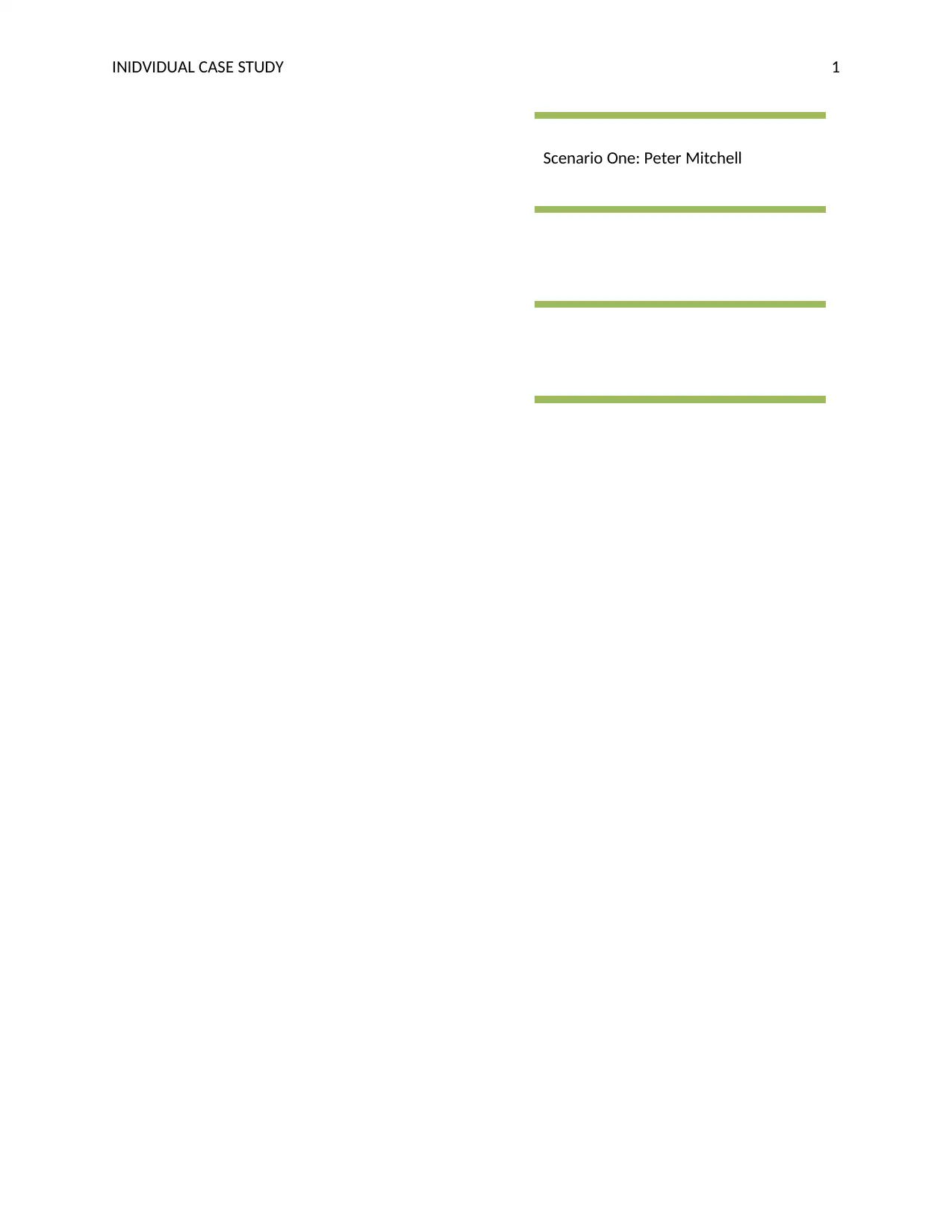
INIDVIDUAL CASE STUDY 1
Scenario One: Peter Mitchell
Scenario One: Peter Mitchell
Paraphrase This Document
Need a fresh take? Get an instant paraphrase of this document with our AI Paraphraser
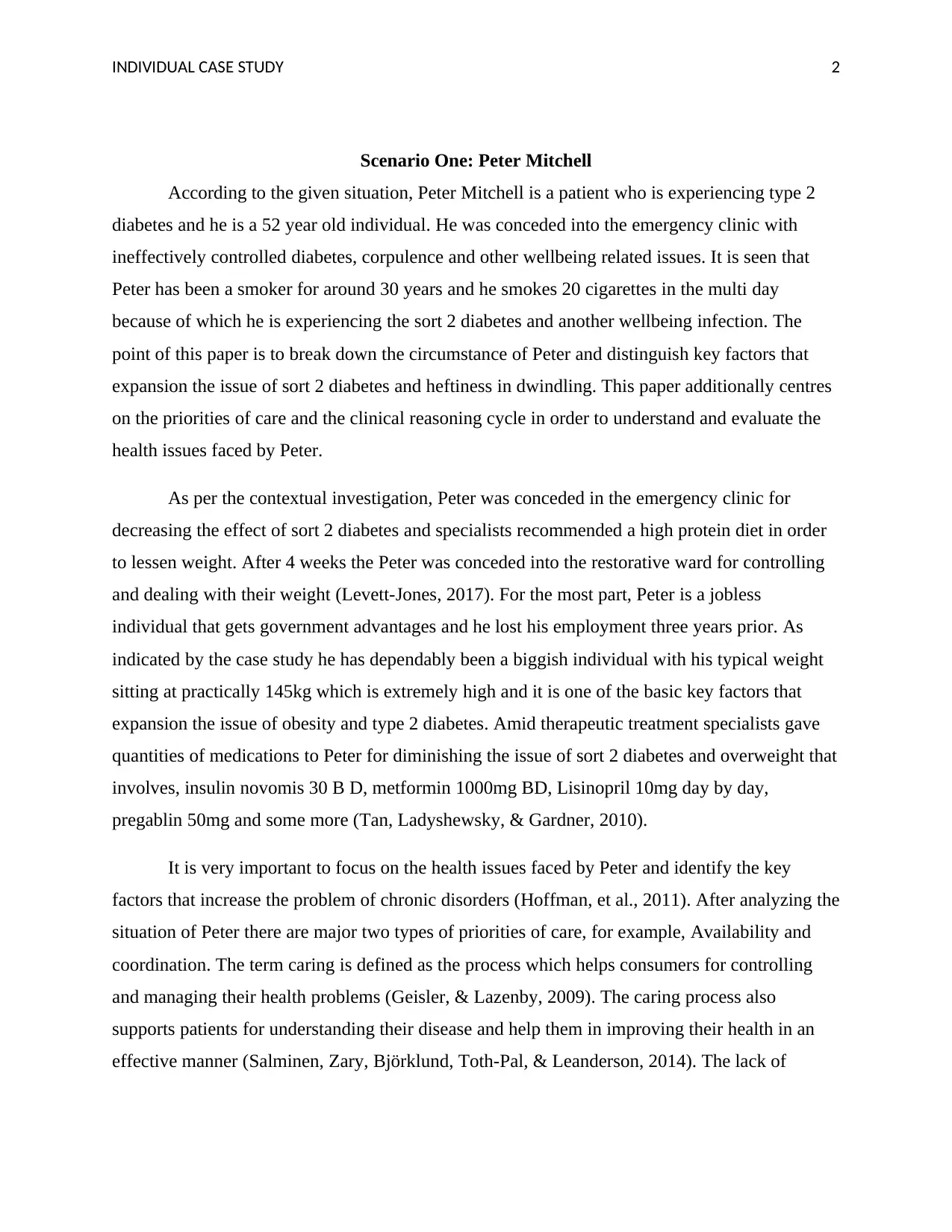
INDIVIDUAL CASE STUDY 2
Scenario One: Peter Mitchell
According to the given situation, Peter Mitchell is a patient who is experiencing type 2
diabetes and he is a 52 year old individual. He was conceded into the emergency clinic with
ineffectively controlled diabetes, corpulence and other wellbeing related issues. It is seen that
Peter has been a smoker for around 30 years and he smokes 20 cigarettes in the multi day
because of which he is experiencing the sort 2 diabetes and another wellbeing infection. The
point of this paper is to break down the circumstance of Peter and distinguish key factors that
expansion the issue of sort 2 diabetes and heftiness in dwindling. This paper additionally centres
on the priorities of care and the clinical reasoning cycle in order to understand and evaluate the
health issues faced by Peter.
As per the contextual investigation, Peter was conceded in the emergency clinic for
decreasing the effect of sort 2 diabetes and specialists recommended a high protein diet in order
to lessen weight. After 4 weeks the Peter was conceded into the restorative ward for controlling
and dealing with their weight (Levett-Jones, 2017). For the most part, Peter is a jobless
individual that gets government advantages and he lost his employment three years prior. As
indicated by the case study he has dependably been a biggish individual with his typical weight
sitting at practically 145kg which is extremely high and it is one of the basic key factors that
expansion the issue of obesity and type 2 diabetes. Amid therapeutic treatment specialists gave
quantities of medications to Peter for diminishing the issue of sort 2 diabetes and overweight that
involves, insulin novomis 30 B D, metformin 1000mg BD, Lisinopril 10mg day by day,
pregablin 50mg and some more (Tan, Ladyshewsky, & Gardner, 2010).
It is very important to focus on the health issues faced by Peter and identify the key
factors that increase the problem of chronic disorders (Hoffman, et al., 2011). After analyzing the
situation of Peter there are major two types of priorities of care, for example, Availability and
coordination. The term caring is defined as the process which helps consumers for controlling
and managing their health problems (Geisler, & Lazenby, 2009). The caring process also
supports patients for understanding their disease and help them in improving their health in an
effective manner (Salminen, Zary, Björklund, Toth-Pal, & Leanderson, 2014). The lack of
Scenario One: Peter Mitchell
According to the given situation, Peter Mitchell is a patient who is experiencing type 2
diabetes and he is a 52 year old individual. He was conceded into the emergency clinic with
ineffectively controlled diabetes, corpulence and other wellbeing related issues. It is seen that
Peter has been a smoker for around 30 years and he smokes 20 cigarettes in the multi day
because of which he is experiencing the sort 2 diabetes and another wellbeing infection. The
point of this paper is to break down the circumstance of Peter and distinguish key factors that
expansion the issue of sort 2 diabetes and heftiness in dwindling. This paper additionally centres
on the priorities of care and the clinical reasoning cycle in order to understand and evaluate the
health issues faced by Peter.
As per the contextual investigation, Peter was conceded in the emergency clinic for
decreasing the effect of sort 2 diabetes and specialists recommended a high protein diet in order
to lessen weight. After 4 weeks the Peter was conceded into the restorative ward for controlling
and dealing with their weight (Levett-Jones, 2017). For the most part, Peter is a jobless
individual that gets government advantages and he lost his employment three years prior. As
indicated by the case study he has dependably been a biggish individual with his typical weight
sitting at practically 145kg which is extremely high and it is one of the basic key factors that
expansion the issue of obesity and type 2 diabetes. Amid therapeutic treatment specialists gave
quantities of medications to Peter for diminishing the issue of sort 2 diabetes and overweight that
involves, insulin novomis 30 B D, metformin 1000mg BD, Lisinopril 10mg day by day,
pregablin 50mg and some more (Tan, Ladyshewsky, & Gardner, 2010).
It is very important to focus on the health issues faced by Peter and identify the key
factors that increase the problem of chronic disorders (Hoffman, et al., 2011). After analyzing the
situation of Peter there are major two types of priorities of care, for example, Availability and
coordination. The term caring is defined as the process which helps consumers for controlling
and managing their health problems (Geisler, & Lazenby, 2009). The caring process also
supports patients for understanding their disease and help them in improving their health in an
effective manner (Salminen, Zary, Björklund, Toth-Pal, & Leanderson, 2014). The lack of
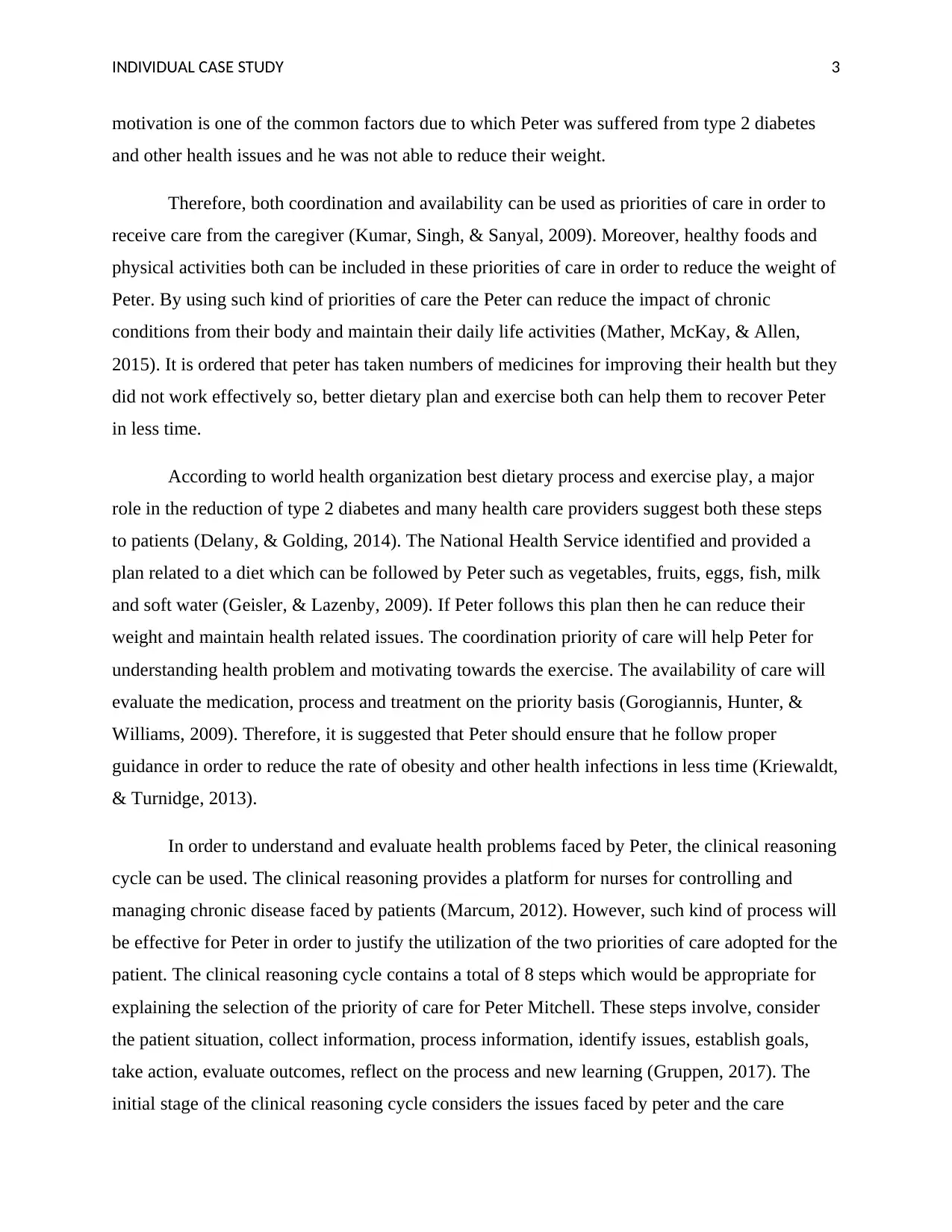
INDIVIDUAL CASE STUDY 3
motivation is one of the common factors due to which Peter was suffered from type 2 diabetes
and other health issues and he was not able to reduce their weight.
Therefore, both coordination and availability can be used as priorities of care in order to
receive care from the caregiver (Kumar, Singh, & Sanyal, 2009). Moreover, healthy foods and
physical activities both can be included in these priorities of care in order to reduce the weight of
Peter. By using such kind of priorities of care the Peter can reduce the impact of chronic
conditions from their body and maintain their daily life activities (Mather, McKay, & Allen,
2015). It is ordered that peter has taken numbers of medicines for improving their health but they
did not work effectively so, better dietary plan and exercise both can help them to recover Peter
in less time.
According to world health organization best dietary process and exercise play, a major
role in the reduction of type 2 diabetes and many health care providers suggest both these steps
to patients (Delany, & Golding, 2014). The National Health Service identified and provided a
plan related to a diet which can be followed by Peter such as vegetables, fruits, eggs, fish, milk
and soft water (Geisler, & Lazenby, 2009). If Peter follows this plan then he can reduce their
weight and maintain health related issues. The coordination priority of care will help Peter for
understanding health problem and motivating towards the exercise. The availability of care will
evaluate the medication, process and treatment on the priority basis (Gorogiannis, Hunter, &
Williams, 2009). Therefore, it is suggested that Peter should ensure that he follow proper
guidance in order to reduce the rate of obesity and other health infections in less time (Kriewaldt,
& Turnidge, 2013).
In order to understand and evaluate health problems faced by Peter, the clinical reasoning
cycle can be used. The clinical reasoning provides a platform for nurses for controlling and
managing chronic disease faced by patients (Marcum, 2012). However, such kind of process will
be effective for Peter in order to justify the utilization of the two priorities of care adopted for the
patient. The clinical reasoning cycle contains a total of 8 steps which would be appropriate for
explaining the selection of the priority of care for Peter Mitchell. These steps involve, consider
the patient situation, collect information, process information, identify issues, establish goals,
take action, evaluate outcomes, reflect on the process and new learning (Gruppen, 2017). The
initial stage of the clinical reasoning cycle considers the issues faced by peter and the care
motivation is one of the common factors due to which Peter was suffered from type 2 diabetes
and other health issues and he was not able to reduce their weight.
Therefore, both coordination and availability can be used as priorities of care in order to
receive care from the caregiver (Kumar, Singh, & Sanyal, 2009). Moreover, healthy foods and
physical activities both can be included in these priorities of care in order to reduce the weight of
Peter. By using such kind of priorities of care the Peter can reduce the impact of chronic
conditions from their body and maintain their daily life activities (Mather, McKay, & Allen,
2015). It is ordered that peter has taken numbers of medicines for improving their health but they
did not work effectively so, better dietary plan and exercise both can help them to recover Peter
in less time.
According to world health organization best dietary process and exercise play, a major
role in the reduction of type 2 diabetes and many health care providers suggest both these steps
to patients (Delany, & Golding, 2014). The National Health Service identified and provided a
plan related to a diet which can be followed by Peter such as vegetables, fruits, eggs, fish, milk
and soft water (Geisler, & Lazenby, 2009). If Peter follows this plan then he can reduce their
weight and maintain health related issues. The coordination priority of care will help Peter for
understanding health problem and motivating towards the exercise. The availability of care will
evaluate the medication, process and treatment on the priority basis (Gorogiannis, Hunter, &
Williams, 2009). Therefore, it is suggested that Peter should ensure that he follow proper
guidance in order to reduce the rate of obesity and other health infections in less time (Kriewaldt,
& Turnidge, 2013).
In order to understand and evaluate health problems faced by Peter, the clinical reasoning
cycle can be used. The clinical reasoning provides a platform for nurses for controlling and
managing chronic disease faced by patients (Marcum, 2012). However, such kind of process will
be effective for Peter in order to justify the utilization of the two priorities of care adopted for the
patient. The clinical reasoning cycle contains a total of 8 steps which would be appropriate for
explaining the selection of the priority of care for Peter Mitchell. These steps involve, consider
the patient situation, collect information, process information, identify issues, establish goals,
take action, evaluate outcomes, reflect on the process and new learning (Gruppen, 2017). The
initial stage of the clinical reasoning cycle considers the issues faced by peter and the care
⊘ This is a preview!⊘
Do you want full access?
Subscribe today to unlock all pages.

Trusted by 1+ million students worldwide
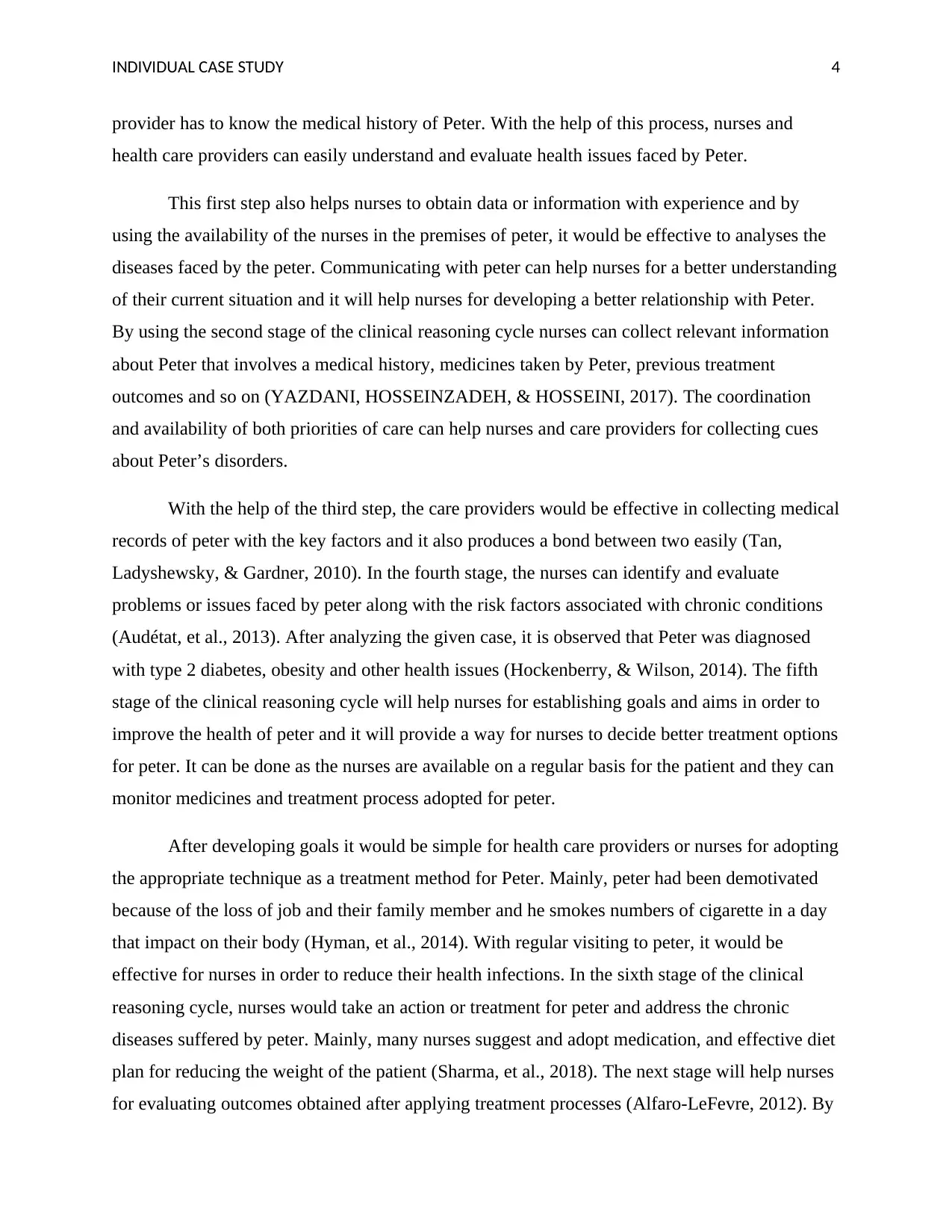
INDIVIDUAL CASE STUDY 4
provider has to know the medical history of Peter. With the help of this process, nurses and
health care providers can easily understand and evaluate health issues faced by Peter.
This first step also helps nurses to obtain data or information with experience and by
using the availability of the nurses in the premises of peter, it would be effective to analyses the
diseases faced by the peter. Communicating with peter can help nurses for a better understanding
of their current situation and it will help nurses for developing a better relationship with Peter.
By using the second stage of the clinical reasoning cycle nurses can collect relevant information
about Peter that involves a medical history, medicines taken by Peter, previous treatment
outcomes and so on (YAZDANI, HOSSEINZADEH, & HOSSEINI, 2017). The coordination
and availability of both priorities of care can help nurses and care providers for collecting cues
about Peter’s disorders.
With the help of the third step, the care providers would be effective in collecting medical
records of peter with the key factors and it also produces a bond between two easily (Tan,
Ladyshewsky, & Gardner, 2010). In the fourth stage, the nurses can identify and evaluate
problems or issues faced by peter along with the risk factors associated with chronic conditions
(Audétat, et al., 2013). After analyzing the given case, it is observed that Peter was diagnosed
with type 2 diabetes, obesity and other health issues (Hockenberry, & Wilson, 2014). The fifth
stage of the clinical reasoning cycle will help nurses for establishing goals and aims in order to
improve the health of peter and it will provide a way for nurses to decide better treatment options
for peter. It can be done as the nurses are available on a regular basis for the patient and they can
monitor medicines and treatment process adopted for peter.
After developing goals it would be simple for health care providers or nurses for adopting
the appropriate technique as a treatment method for Peter. Mainly, peter had been demotivated
because of the loss of job and their family member and he smokes numbers of cigarette in a day
that impact on their body (Hyman, et al., 2014). With regular visiting to peter, it would be
effective for nurses in order to reduce their health infections. In the sixth stage of the clinical
reasoning cycle, nurses would take an action or treatment for peter and address the chronic
diseases suffered by peter. Mainly, many nurses suggest and adopt medication, and effective diet
plan for reducing the weight of the patient (Sharma, et al., 2018). The next stage will help nurses
for evaluating outcomes obtained after applying treatment processes (Alfaro-LeFevre, 2012). By
provider has to know the medical history of Peter. With the help of this process, nurses and
health care providers can easily understand and evaluate health issues faced by Peter.
This first step also helps nurses to obtain data or information with experience and by
using the availability of the nurses in the premises of peter, it would be effective to analyses the
diseases faced by the peter. Communicating with peter can help nurses for a better understanding
of their current situation and it will help nurses for developing a better relationship with Peter.
By using the second stage of the clinical reasoning cycle nurses can collect relevant information
about Peter that involves a medical history, medicines taken by Peter, previous treatment
outcomes and so on (YAZDANI, HOSSEINZADEH, & HOSSEINI, 2017). The coordination
and availability of both priorities of care can help nurses and care providers for collecting cues
about Peter’s disorders.
With the help of the third step, the care providers would be effective in collecting medical
records of peter with the key factors and it also produces a bond between two easily (Tan,
Ladyshewsky, & Gardner, 2010). In the fourth stage, the nurses can identify and evaluate
problems or issues faced by peter along with the risk factors associated with chronic conditions
(Audétat, et al., 2013). After analyzing the given case, it is observed that Peter was diagnosed
with type 2 diabetes, obesity and other health issues (Hockenberry, & Wilson, 2014). The fifth
stage of the clinical reasoning cycle will help nurses for establishing goals and aims in order to
improve the health of peter and it will provide a way for nurses to decide better treatment options
for peter. It can be done as the nurses are available on a regular basis for the patient and they can
monitor medicines and treatment process adopted for peter.
After developing goals it would be simple for health care providers or nurses for adopting
the appropriate technique as a treatment method for Peter. Mainly, peter had been demotivated
because of the loss of job and their family member and he smokes numbers of cigarette in a day
that impact on their body (Hyman, et al., 2014). With regular visiting to peter, it would be
effective for nurses in order to reduce their health infections. In the sixth stage of the clinical
reasoning cycle, nurses would take an action or treatment for peter and address the chronic
diseases suffered by peter. Mainly, many nurses suggest and adopt medication, and effective diet
plan for reducing the weight of the patient (Sharma, et al., 2018). The next stage will help nurses
for evaluating outcomes obtained after applying treatment processes (Alfaro-LeFevre, 2012). By
Paraphrase This Document
Need a fresh take? Get an instant paraphrase of this document with our AI Paraphraser
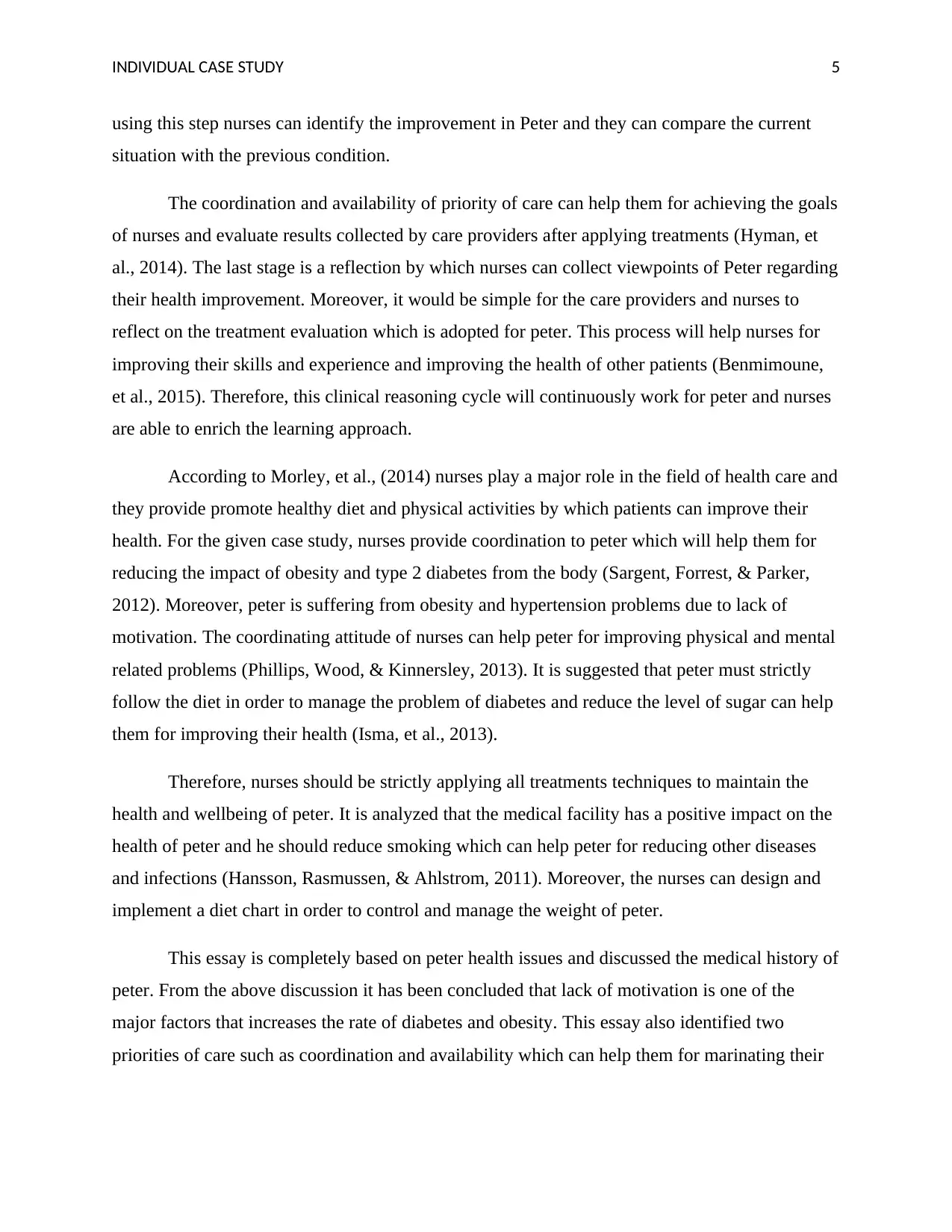
INDIVIDUAL CASE STUDY 5
using this step nurses can identify the improvement in Peter and they can compare the current
situation with the previous condition.
The coordination and availability of priority of care can help them for achieving the goals
of nurses and evaluate results collected by care providers after applying treatments (Hyman, et
al., 2014). The last stage is a reflection by which nurses can collect viewpoints of Peter regarding
their health improvement. Moreover, it would be simple for the care providers and nurses to
reflect on the treatment evaluation which is adopted for peter. This process will help nurses for
improving their skills and experience and improving the health of other patients (Benmimoune,
et al., 2015). Therefore, this clinical reasoning cycle will continuously work for peter and nurses
are able to enrich the learning approach.
According to Morley, et al., (2014) nurses play a major role in the field of health care and
they provide promote healthy diet and physical activities by which patients can improve their
health. For the given case study, nurses provide coordination to peter which will help them for
reducing the impact of obesity and type 2 diabetes from the body (Sargent, Forrest, & Parker,
2012). Moreover, peter is suffering from obesity and hypertension problems due to lack of
motivation. The coordinating attitude of nurses can help peter for improving physical and mental
related problems (Phillips, Wood, & Kinnersley, 2013). It is suggested that peter must strictly
follow the diet in order to manage the problem of diabetes and reduce the level of sugar can help
them for improving their health (Isma, et al., 2013).
Therefore, nurses should be strictly applying all treatments techniques to maintain the
health and wellbeing of peter. It is analyzed that the medical facility has a positive impact on the
health of peter and he should reduce smoking which can help peter for reducing other diseases
and infections (Hansson, Rasmussen, & Ahlstrom, 2011). Moreover, the nurses can design and
implement a diet chart in order to control and manage the weight of peter.
This essay is completely based on peter health issues and discussed the medical history of
peter. From the above discussion it has been concluded that lack of motivation is one of the
major factors that increases the rate of diabetes and obesity. This essay also identified two
priorities of care such as coordination and availability which can help them for marinating their
using this step nurses can identify the improvement in Peter and they can compare the current
situation with the previous condition.
The coordination and availability of priority of care can help them for achieving the goals
of nurses and evaluate results collected by care providers after applying treatments (Hyman, et
al., 2014). The last stage is a reflection by which nurses can collect viewpoints of Peter regarding
their health improvement. Moreover, it would be simple for the care providers and nurses to
reflect on the treatment evaluation which is adopted for peter. This process will help nurses for
improving their skills and experience and improving the health of other patients (Benmimoune,
et al., 2015). Therefore, this clinical reasoning cycle will continuously work for peter and nurses
are able to enrich the learning approach.
According to Morley, et al., (2014) nurses play a major role in the field of health care and
they provide promote healthy diet and physical activities by which patients can improve their
health. For the given case study, nurses provide coordination to peter which will help them for
reducing the impact of obesity and type 2 diabetes from the body (Sargent, Forrest, & Parker,
2012). Moreover, peter is suffering from obesity and hypertension problems due to lack of
motivation. The coordinating attitude of nurses can help peter for improving physical and mental
related problems (Phillips, Wood, & Kinnersley, 2013). It is suggested that peter must strictly
follow the diet in order to manage the problem of diabetes and reduce the level of sugar can help
them for improving their health (Isma, et al., 2013).
Therefore, nurses should be strictly applying all treatments techniques to maintain the
health and wellbeing of peter. It is analyzed that the medical facility has a positive impact on the
health of peter and he should reduce smoking which can help peter for reducing other diseases
and infections (Hansson, Rasmussen, & Ahlstrom, 2011). Moreover, the nurses can design and
implement a diet chart in order to control and manage the weight of peter.
This essay is completely based on peter health issues and discussed the medical history of
peter. From the above discussion it has been concluded that lack of motivation is one of the
major factors that increases the rate of diabetes and obesity. This essay also identified two
priorities of care such as coordination and availability which can help them for marinating their

INDIVIDUAL CASE STUDY 6
health situations. It has been suggested that adopting the appropriate dietary plan and physical
activities can help peter for reducing their weight.
health situations. It has been suggested that adopting the appropriate dietary plan and physical
activities can help peter for reducing their weight.
⊘ This is a preview!⊘
Do you want full access?
Subscribe today to unlock all pages.

Trusted by 1+ million students worldwide
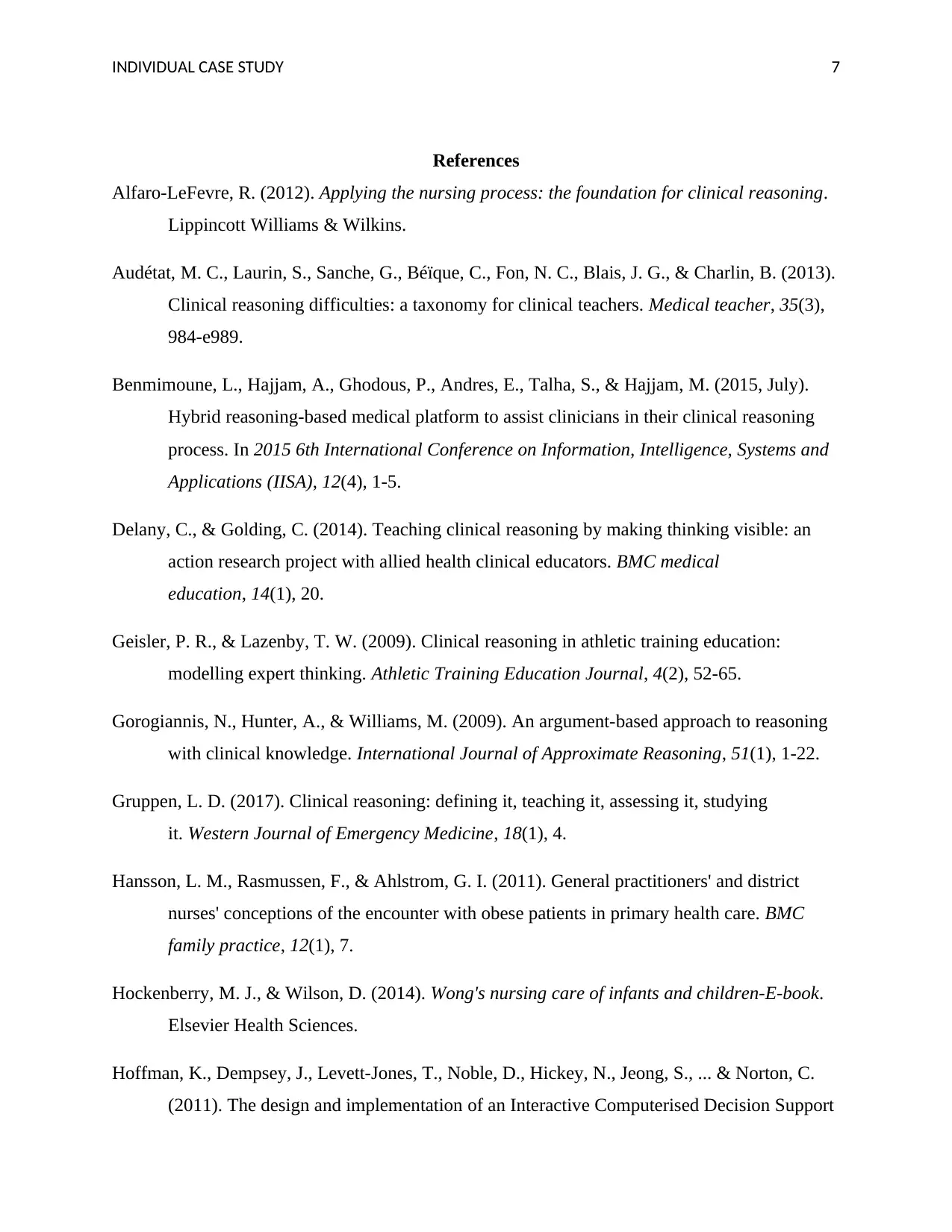
INDIVIDUAL CASE STUDY 7
References
Alfaro-LeFevre, R. (2012). Applying the nursing process: the foundation for clinical reasoning.
Lippincott Williams & Wilkins.
Audétat, M. C., Laurin, S., Sanche, G., Béïque, C., Fon, N. C., Blais, J. G., & Charlin, B. (2013).
Clinical reasoning difficulties: a taxonomy for clinical teachers. Medical teacher, 35(3),
984-e989.
Benmimoune, L., Hajjam, A., Ghodous, P., Andres, E., Talha, S., & Hajjam, M. (2015, July).
Hybrid reasoning-based medical platform to assist clinicians in their clinical reasoning
process. In 2015 6th International Conference on Information, Intelligence, Systems and
Applications (IISA), 12(4), 1-5.
Delany, C., & Golding, C. (2014). Teaching clinical reasoning by making thinking visible: an
action research project with allied health clinical educators. BMC medical
education, 14(1), 20.
Geisler, P. R., & Lazenby, T. W. (2009). Clinical reasoning in athletic training education:
modelling expert thinking. Athletic Training Education Journal, 4(2), 52-65.
Gorogiannis, N., Hunter, A., & Williams, M. (2009). An argument-based approach to reasoning
with clinical knowledge. International Journal of Approximate Reasoning, 51(1), 1-22.
Gruppen, L. D. (2017). Clinical reasoning: defining it, teaching it, assessing it, studying
it. Western Journal of Emergency Medicine, 18(1), 4.
Hansson, L. M., Rasmussen, F., & Ahlstrom, G. I. (2011). General practitioners' and district
nurses' conceptions of the encounter with obese patients in primary health care. BMC
family practice, 12(1), 7.
Hockenberry, M. J., & Wilson, D. (2014). Wong's nursing care of infants and children-E-book.
Elsevier Health Sciences.
Hoffman, K., Dempsey, J., Levett-Jones, T., Noble, D., Hickey, N., Jeong, S., ... & Norton, C.
(2011). The design and implementation of an Interactive Computerised Decision Support
References
Alfaro-LeFevre, R. (2012). Applying the nursing process: the foundation for clinical reasoning.
Lippincott Williams & Wilkins.
Audétat, M. C., Laurin, S., Sanche, G., Béïque, C., Fon, N. C., Blais, J. G., & Charlin, B. (2013).
Clinical reasoning difficulties: a taxonomy for clinical teachers. Medical teacher, 35(3),
984-e989.
Benmimoune, L., Hajjam, A., Ghodous, P., Andres, E., Talha, S., & Hajjam, M. (2015, July).
Hybrid reasoning-based medical platform to assist clinicians in their clinical reasoning
process. In 2015 6th International Conference on Information, Intelligence, Systems and
Applications (IISA), 12(4), 1-5.
Delany, C., & Golding, C. (2014). Teaching clinical reasoning by making thinking visible: an
action research project with allied health clinical educators. BMC medical
education, 14(1), 20.
Geisler, P. R., & Lazenby, T. W. (2009). Clinical reasoning in athletic training education:
modelling expert thinking. Athletic Training Education Journal, 4(2), 52-65.
Gorogiannis, N., Hunter, A., & Williams, M. (2009). An argument-based approach to reasoning
with clinical knowledge. International Journal of Approximate Reasoning, 51(1), 1-22.
Gruppen, L. D. (2017). Clinical reasoning: defining it, teaching it, assessing it, studying
it. Western Journal of Emergency Medicine, 18(1), 4.
Hansson, L. M., Rasmussen, F., & Ahlstrom, G. I. (2011). General practitioners' and district
nurses' conceptions of the encounter with obese patients in primary health care. BMC
family practice, 12(1), 7.
Hockenberry, M. J., & Wilson, D. (2014). Wong's nursing care of infants and children-E-book.
Elsevier Health Sciences.
Hoffman, K., Dempsey, J., Levett-Jones, T., Noble, D., Hickey, N., Jeong, S., ... & Norton, C.
(2011). The design and implementation of an Interactive Computerised Decision Support
Paraphrase This Document
Need a fresh take? Get an instant paraphrase of this document with our AI Paraphraser
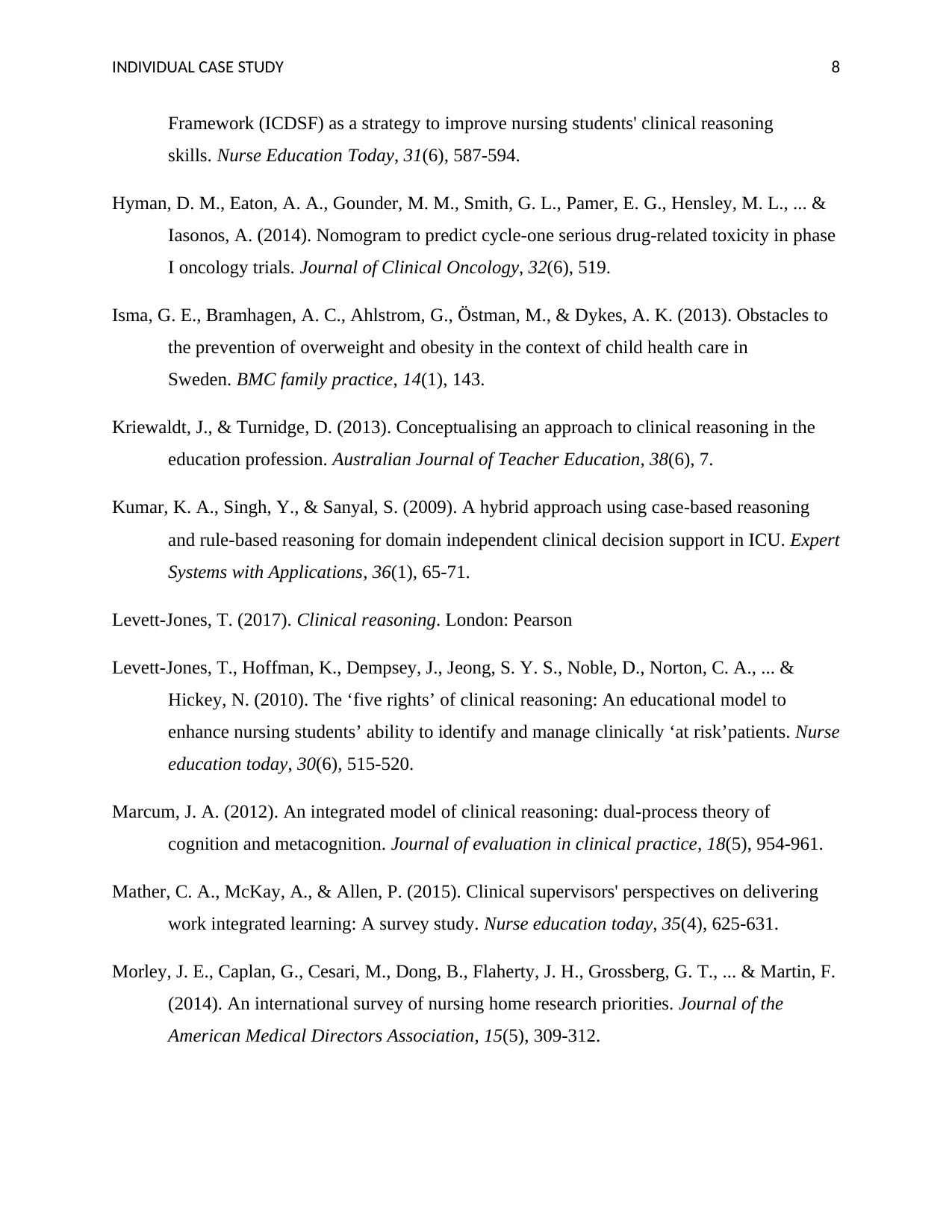
INDIVIDUAL CASE STUDY 8
Framework (ICDSF) as a strategy to improve nursing students' clinical reasoning
skills. Nurse Education Today, 31(6), 587-594.
Hyman, D. M., Eaton, A. A., Gounder, M. M., Smith, G. L., Pamer, E. G., Hensley, M. L., ... &
Iasonos, A. (2014). Nomogram to predict cycle-one serious drug-related toxicity in phase
I oncology trials. Journal of Clinical Oncology, 32(6), 519.
Isma, G. E., Bramhagen, A. C., Ahlstrom, G., Östman, M., & Dykes, A. K. (2013). Obstacles to
the prevention of overweight and obesity in the context of child health care in
Sweden. BMC family practice, 14(1), 143.
Kriewaldt, J., & Turnidge, D. (2013). Conceptualising an approach to clinical reasoning in the
education profession. Australian Journal of Teacher Education, 38(6), 7.
Kumar, K. A., Singh, Y., & Sanyal, S. (2009). A hybrid approach using case-based reasoning
and rule-based reasoning for domain independent clinical decision support in ICU. Expert
Systems with Applications, 36(1), 65-71.
Levett-Jones, T. (2017). Clinical reasoning. London: Pearson
Levett-Jones, T., Hoffman, K., Dempsey, J., Jeong, S. Y. S., Noble, D., Norton, C. A., ... &
Hickey, N. (2010). The ‘five rights’ of clinical reasoning: An educational model to
enhance nursing students’ ability to identify and manage clinically ‘at risk’patients. Nurse
education today, 30(6), 515-520.
Marcum, J. A. (2012). An integrated model of clinical reasoning: dual‐process theory of
cognition and metacognition. Journal of evaluation in clinical practice, 18(5), 954-961.
Mather, C. A., McKay, A., & Allen, P. (2015). Clinical supervisors' perspectives on delivering
work integrated learning: A survey study. Nurse education today, 35(4), 625-631.
Morley, J. E., Caplan, G., Cesari, M., Dong, B., Flaherty, J. H., Grossberg, G. T., ... & Martin, F.
(2014). An international survey of nursing home research priorities. Journal of the
American Medical Directors Association, 15(5), 309-312.
Framework (ICDSF) as a strategy to improve nursing students' clinical reasoning
skills. Nurse Education Today, 31(6), 587-594.
Hyman, D. M., Eaton, A. A., Gounder, M. M., Smith, G. L., Pamer, E. G., Hensley, M. L., ... &
Iasonos, A. (2014). Nomogram to predict cycle-one serious drug-related toxicity in phase
I oncology trials. Journal of Clinical Oncology, 32(6), 519.
Isma, G. E., Bramhagen, A. C., Ahlstrom, G., Östman, M., & Dykes, A. K. (2013). Obstacles to
the prevention of overweight and obesity in the context of child health care in
Sweden. BMC family practice, 14(1), 143.
Kriewaldt, J., & Turnidge, D. (2013). Conceptualising an approach to clinical reasoning in the
education profession. Australian Journal of Teacher Education, 38(6), 7.
Kumar, K. A., Singh, Y., & Sanyal, S. (2009). A hybrid approach using case-based reasoning
and rule-based reasoning for domain independent clinical decision support in ICU. Expert
Systems with Applications, 36(1), 65-71.
Levett-Jones, T. (2017). Clinical reasoning. London: Pearson
Levett-Jones, T., Hoffman, K., Dempsey, J., Jeong, S. Y. S., Noble, D., Norton, C. A., ... &
Hickey, N. (2010). The ‘five rights’ of clinical reasoning: An educational model to
enhance nursing students’ ability to identify and manage clinically ‘at risk’patients. Nurse
education today, 30(6), 515-520.
Marcum, J. A. (2012). An integrated model of clinical reasoning: dual‐process theory of
cognition and metacognition. Journal of evaluation in clinical practice, 18(5), 954-961.
Mather, C. A., McKay, A., & Allen, P. (2015). Clinical supervisors' perspectives on delivering
work integrated learning: A survey study. Nurse education today, 35(4), 625-631.
Morley, J. E., Caplan, G., Cesari, M., Dong, B., Flaherty, J. H., Grossberg, G. T., ... & Martin, F.
(2014). An international survey of nursing home research priorities. Journal of the
American Medical Directors Association, 15(5), 309-312.
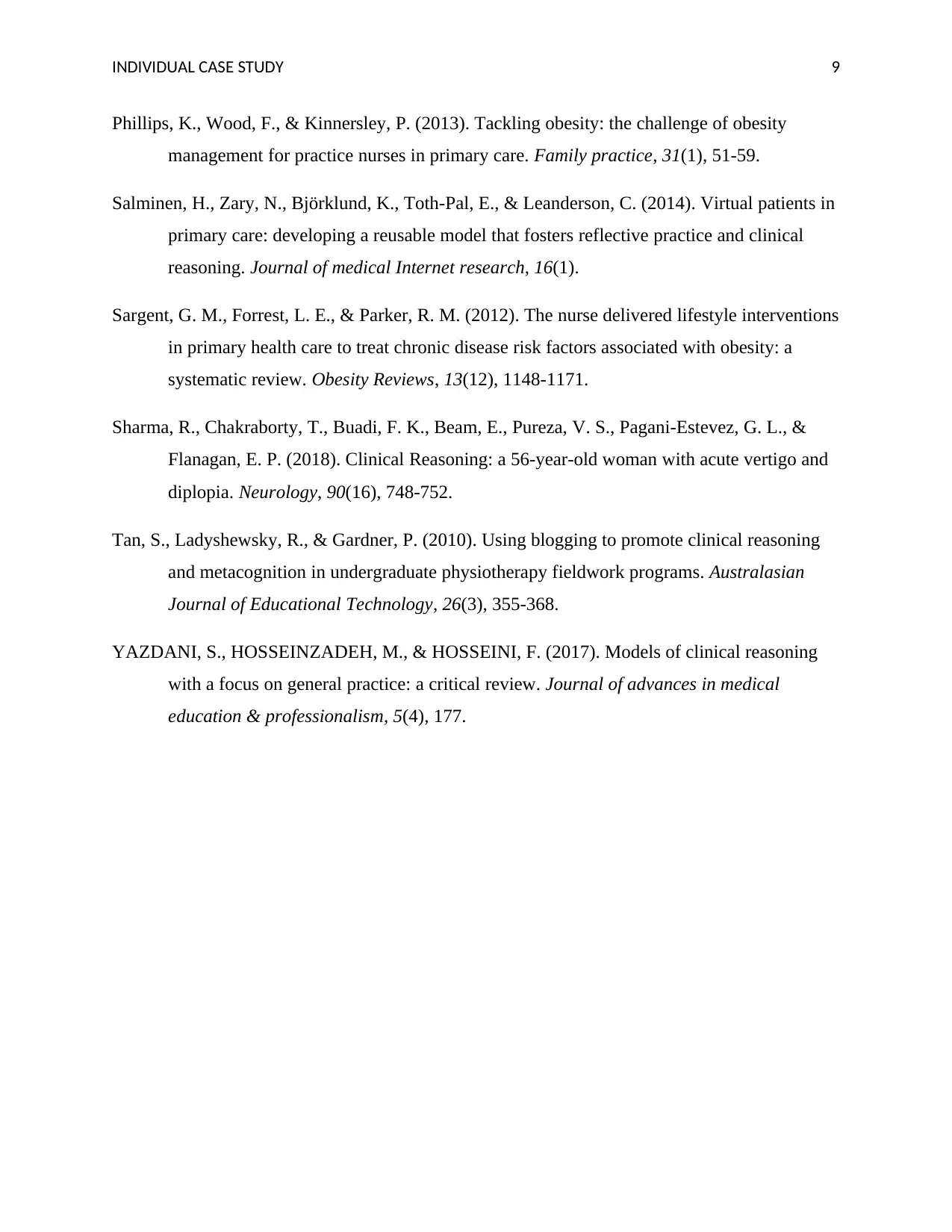
INDIVIDUAL CASE STUDY 9
Phillips, K., Wood, F., & Kinnersley, P. (2013). Tackling obesity: the challenge of obesity
management for practice nurses in primary care. Family practice, 31(1), 51-59.
Salminen, H., Zary, N., Björklund, K., Toth-Pal, E., & Leanderson, C. (2014). Virtual patients in
primary care: developing a reusable model that fosters reflective practice and clinical
reasoning. Journal of medical Internet research, 16(1).
Sargent, G. M., Forrest, L. E., & Parker, R. M. (2012). The nurse delivered lifestyle interventions
in primary health care to treat chronic disease risk factors associated with obesity: a
systematic review. Obesity Reviews, 13(12), 1148-1171.
Sharma, R., Chakraborty, T., Buadi, F. K., Beam, E., Pureza, V. S., Pagani-Estevez, G. L., &
Flanagan, E. P. (2018). Clinical Reasoning: a 56-year-old woman with acute vertigo and
diplopia. Neurology, 90(16), 748-752.
Tan, S., Ladyshewsky, R., & Gardner, P. (2010). Using blogging to promote clinical reasoning
and metacognition in undergraduate physiotherapy fieldwork programs. Australasian
Journal of Educational Technology, 26(3), 355-368.
YAZDANI, S., HOSSEINZADEH, M., & HOSSEINI, F. (2017). Models of clinical reasoning
with a focus on general practice: a critical review. Journal of advances in medical
education & professionalism, 5(4), 177.
Phillips, K., Wood, F., & Kinnersley, P. (2013). Tackling obesity: the challenge of obesity
management for practice nurses in primary care. Family practice, 31(1), 51-59.
Salminen, H., Zary, N., Björklund, K., Toth-Pal, E., & Leanderson, C. (2014). Virtual patients in
primary care: developing a reusable model that fosters reflective practice and clinical
reasoning. Journal of medical Internet research, 16(1).
Sargent, G. M., Forrest, L. E., & Parker, R. M. (2012). The nurse delivered lifestyle interventions
in primary health care to treat chronic disease risk factors associated with obesity: a
systematic review. Obesity Reviews, 13(12), 1148-1171.
Sharma, R., Chakraborty, T., Buadi, F. K., Beam, E., Pureza, V. S., Pagani-Estevez, G. L., &
Flanagan, E. P. (2018). Clinical Reasoning: a 56-year-old woman with acute vertigo and
diplopia. Neurology, 90(16), 748-752.
Tan, S., Ladyshewsky, R., & Gardner, P. (2010). Using blogging to promote clinical reasoning
and metacognition in undergraduate physiotherapy fieldwork programs. Australasian
Journal of Educational Technology, 26(3), 355-368.
YAZDANI, S., HOSSEINZADEH, M., & HOSSEINI, F. (2017). Models of clinical reasoning
with a focus on general practice: a critical review. Journal of advances in medical
education & professionalism, 5(4), 177.
⊘ This is a preview!⊘
Do you want full access?
Subscribe today to unlock all pages.

Trusted by 1+ million students worldwide
1 out of 9
Related Documents
Your All-in-One AI-Powered Toolkit for Academic Success.
+13062052269
info@desklib.com
Available 24*7 on WhatsApp / Email
![[object Object]](/_next/static/media/star-bottom.7253800d.svg)
Unlock your academic potential
Copyright © 2020–2025 A2Z Services. All Rights Reserved. Developed and managed by ZUCOL.





